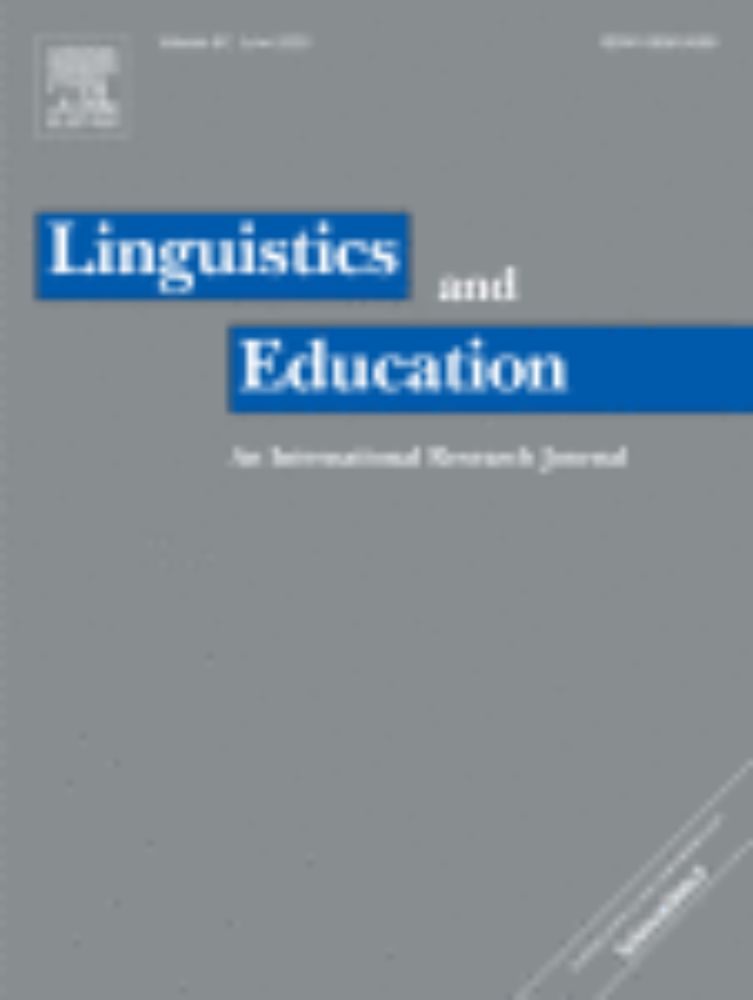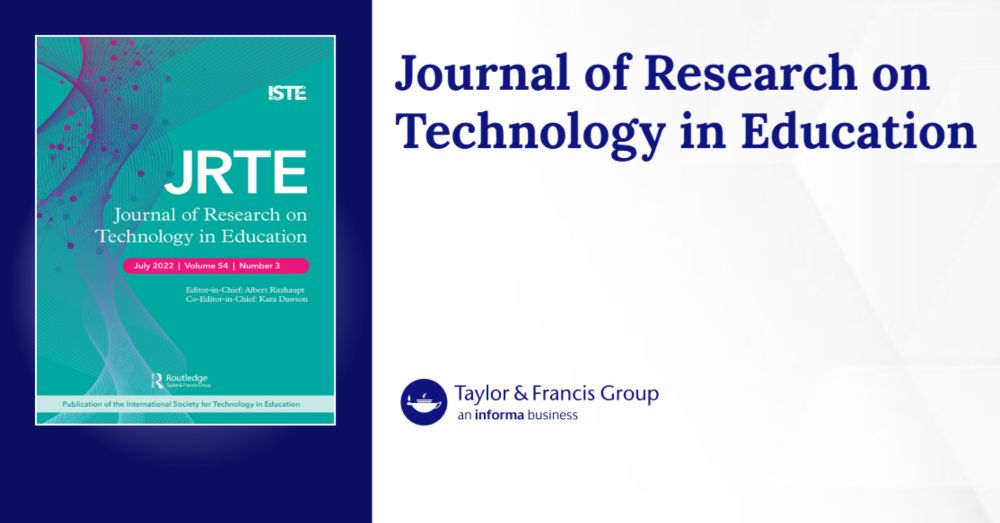
New article out in Classroom Discourse!: "Forms of becoming: elementary students’ self-positioning in writing" (by Maryam Khosronejad, Mary Ryan & Lauren Alexandra Weber). www.tandfonline.com/doi/full/10....
11.07.2025 15:45 — 👍 6 🔁 2 💬 0 📌 0@classroomdiscourse.bsky.social
An international journal published by Routledge. Edited by Olcay Sert & SilviaKunitz. 2023 CiteScore: 3.4 (Q1), SNIP: 0.87; WOS IF: 1.5. https://www.tandfonline.com/journals/rcdi20

New article out in Classroom Discourse!: "Forms of becoming: elementary students’ self-positioning in writing" (by Maryam Khosronejad, Mary Ryan & Lauren Alexandra Weber). www.tandfonline.com/doi/full/10....
11.07.2025 15:45 — 👍 6 🔁 2 💬 0 📌 0
A new #openaccess article, published in Linguistics and Education, by our researchers @marwaamri.bsky.social & @sertolcay.bsky.social: "Teachers’ responses in student-initiated question sequences during between-desk interactions in #EFL project work" www.sciencedirect.com/science/arti... #CA
11.07.2025 15:05 — 👍 3 🔁 1 💬 0 📌 1
The special issue is concluded by Jan Berenst and Marjolein Deunk's with their insightful commentary: doi.org/10.1080/1946... /8.
10.07.2025 17:32 — 👍 0 🔁 0 💬 0 📌 0
In the sixth study published in the special issue, Naomi de Ruiter & Mayra Mascareño Lara focus on the use of T-pattern analysis to map classroom interactions: doi.org/10.1080/1946... /7 👇
10.07.2025 17:32 — 👍 0 🔁 0 💬 1 📌 0
In the fifth article, Linda Hendriks, Elisa Kupers, Henderien Steenbeek, Evert Bisschop Boele & Paul van Geert walk the readers through the use of state space grids for analysing teacher–student interaction: doi.org/10.1080/1946... /6 👇
10.07.2025 17:32 — 👍 0 🔁 0 💬 1 📌 0
The fourth article in the issue, co-authored by Heleen (Helena) Pennings, Marloes Hendrickx, Marieke Thurlings & Perry den Brok, illustrates the application of orbital decomposition analysis to study the dynamic quality of teacher–teacher interactions: doi.org/10.1080/1946... /5 👇
10.07.2025 17:32 — 👍 0 🔁 0 💬 1 📌 0
In the third article, Sara Hennessy presents Tech-SEDA, "a systematic, research-informed and practical tool for analysing verbal and nonverbal dialogic communication at the micro- or meso- level across diverse educational settings": doi.org/10.1080/1946... /4 👇
10.07.2025 17:32 — 👍 1 🔁 0 💬 1 📌 0
The second article in the issue co-authored by OlcaySert Annaliina Gynne & Maria Larsson unpacks how Discursive Timeline Analysis can be deployed to document teacher-learning over-time, using data from classrooms, post observation conferences and written reflections doi.org/10.1080/1946... /3 👇
10.07.2025 17:32 — 👍 0 🔁 0 💬 1 📌 0
In the first article, Myrte Gosen, Annerose Willemsen & Frans Hiddink showcase the use of Conversation Analysis to analyse classroom interaction, with a focus on students’ ‘oh’-prefaced utterances and the interactional management of explanations doi.org/10.1080/1946... /2 👇
10.07.2025 17:32 — 👍 0 🔁 0 💬 1 📌 0
The issue opens with an introduction by the special issue editors Tom Koole, Elisa Kupers & Mayra Mascareño Lara: Exploring the methodological breadth of research on educational interactions doi.org/10.1080/1946... /1 👇
10.07.2025 17:32 — 👍 0 🔁 0 💬 1 📌 0
A new SI of Classroom Discourse is now out!:"Analyzing educational interactions: exploring the methodological breadth" www.tandfonline.com/toc/rcdi20/1.... The issue features qualitative &quantitative studies that showcase methodologies & the use of empirical data to analyse classroom discourse /0👇
10.07.2025 17:32 — 👍 6 🔁 3 💬 1 📌 0
It has been eye opening for me to listen to the perspectives of student-teachers on their use of an AI tool for #reflective #practice: Partnering with #AI in #teacher #education? Using an automatic question detection tool to reflect on #classroom #interaction: www.tandfonline.com/doi/full/10....
19.05.2025 19:55 — 👍 4 🔁 3 💬 0 📌 0
New article out! Repairing problems of acceptability in pre-task interaction (by David Shimamoto, Kobe University, Japan) www.tandfonline.com/doi/full/10....
19.05.2025 12:43 — 👍 4 🔁 3 💬 0 📌 0
New article out! “Sit like princess/prince”: the making of neoliberal subjects in communication classrooms in the Philippines, by Carlo G. Soberano www.tandfonline.com/doi/full/10....
03.04.2025 01:37 — 👍 3 🔁 1 💬 0 📌 0
New #openaccess article out! Laughter, failure talk, and the sensitive nature of negative feedback, by Gustav Lymer, Oskar Lindwall & Charlott Sellberg. www.tandfonline.com/doi/full/10....
26.03.2025 14:44 — 👍 6 🔁 3 💬 0 📌 0
New article out! "Oral corrective feedback and learner uptake: an analysis of Chinese high-school teachers’ practices in a national teaching competition", by Chi Zhang, Neil E.J.A. Bowen & Nathan Thomas doi.org/10.1080/1946...
25.03.2025 14:37 — 👍 3 🔁 2 💬 0 📌 0
Using T-pattern analysis to map classroom interactions: a case study of student and teacher learning-orientation, by Naomi de Ruiter & Mayra Mascareño Lara doi.org/10.1080/1946... (Part of the forthcoming special issue "Analyzing educational interactions - exploring the methodological breadth")
06.03.2025 20:40 — 👍 3 🔁 2 💬 0 📌 0
New #openaccess article out! Building affiliation in the L2 classroom: the role of side sequences, by Tianfang Wang, Joan Kelly Hall, Yingliang He, Yuanheng (Arthur) Wang, Shuyuan Liu & Su Yin Khor doi.org/10.1080/1946...
05.03.2025 14:51 — 👍 2 🔁 1 💬 0 📌 1
Accomplishing lesson ending: bringing lesson to an end, by Mehmet Ali İçbay @maicbay.bsky.social (Çanakkale Onsekiz Mart University, Türkiye) doi.org/10.1080/1946... /5.
21.02.2025 12:42 — 👍 4 🔁 2 💬 0 📌 0
Making sense of making: bringing a design and making project to school, by Tiina Keisanen, Leena Kuure, Netta Iivari, Marianne Kinnula (University of Oulu, Oulu, Finland) doi.org/10.1080/1946... /4 👇
21.02.2025 12:42 — 👍 2 🔁 1 💬 1 📌 0
Examining authorial agency in elementary children’s narratives, by Mary Ryan & Maryam Khosronejad (Australian Catholic University) doi.org/10.1080/1946... /3 👇
21.02.2025 12:42 — 👍 2 🔁 1 💬 1 📌 0
The embodied nature of students’ engagement and participation during a total physical response activity, by Mai-Han Nguyen (University of Hawaii at Manoa) doi.org/10.1080/1946... /2 👇
21.02.2025 12:42 — 👍 2 🔁 1 💬 1 📌 0
Collaborative character searches in L2 Chinese peer writing: sequential design and object affordances, by Mengying Zhai (University of Idaho) www.tandfonline.com/doi/full/10.... /1 👇
21.02.2025 12:42 — 👍 2 🔁 1 💬 1 📌 0Our new issue is out! It features articles that investigate L2 Chinese peer writing, student engagement in English classes in the US, elementary children’s narratives in Australia, a design and making project in a Finnish school, and lesson endings in a high school classroom in Türkiye. 👇 /0
21.02.2025 12:42 — 👍 6 🔁 3 💬 1 📌 1
Dialogic interaction between young writers: spontaneous vs. structured collaboration, by Manuel Montanero, Manuel Lucero, María-Jesús Fernández-Sánchez, Cristina Amante, Daniel Lázaro doi.org/10.1080/1946...
18.02.2025 19:56 — 👍 1 🔁 1 💬 0 📌 0
New #openaccess article out! "Online intercultural exchange in language teacher education: interactional resources for topic transition" by Müge Satar & Betül Çimenli Olcars doi.org/10.1080/1946... #CA #TESOL
16.02.2025 08:17 — 👍 7 🔁 2 💬 0 📌 0
New special issue article(Analyzing educational interactions: exploring the methodological breadth) by Sara Hennessy (University of Cambridge): Analysing educational dialogue around shared artefacts in technology-mediated contexts: a new coding framework www.tandfonline.com/doi/full/10....
14.02.2025 17:04 — 👍 0 🔁 0 💬 0 📌 0Classroom Discourse is now on Bluesky! Follow @classroomdiscourse.bsky.social to get updates on the articles published in the journal and more! Please spread the word!
14.02.2025 16:54 — 👍 2 🔁 2 💬 0 📌 0